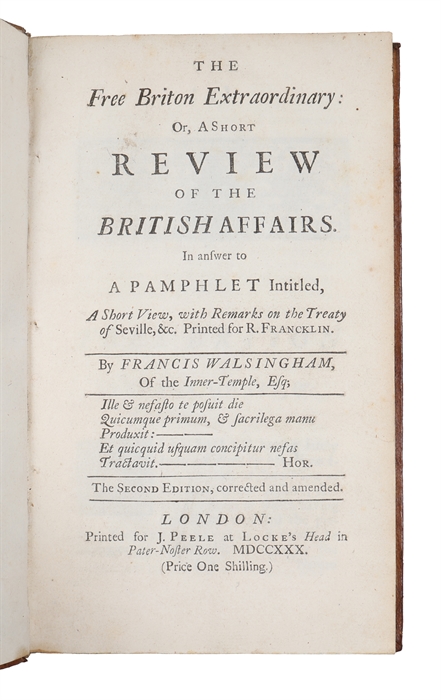CONTEMPORARY BRITISH COMMENTARIES OF THE TREATY OF SEVILLE
WALSINGHAM, FRANCIS (pseu) (WILLIAM ARNALL)
The Free Briton Extraordinary: Or, A Short Review of the British Affairs. In answer to a Pamphlet Intitled, A Short View, with Remarks on the Treaty of Seville (+) A Short View of the State of Affairs with relation to Great Britain for four years past (+) The Treaty of Seville, and the measures that have been taken for the four last years, impartially considered (+) The Observations on the Treaty of Seville examined (+) Observations upon the Treaty between the Crowns of Great-Britain, France, and Spain, concluded at Seville on the Ninth of November, 1729 (+) The Treaty of Peace, Union, Friedship and Mutual Defence between crowns of Great-Britain, France and Spain.
London, 1730 (+) London, Francklin, 1730 (+) London, Robert's, 1730 (+) London, Francklin,1730 (+) London, 1729 (+) (London), 1729.
8vo. In contemporary full calf with five raised bands and gilt lettering and ornamentation to spine. Edges of boards gilt. Gilt Super ex-libris to both front and back board. Ex-libris pasted on to pasted down front end-paper. Parts of gilting on spine worn off. Hole in the leather to front board, affecting the super ex-libris. A good copy. 55, (1), 36, 32, 34, (2), 29, (1), 23 pp.
A highly interesting sammelband with six works all dealing with the Treaty of Seville, formally ending the 1727–1729 Anglo-Spanish War. This treaty was a significant diplomatic agreement between Great Britain, France, and Spain that aimed to resolve ongoing conflicts and tensions among these powers, particularly concerning territorial disputes and trade relations in Europe and the Americas. The treaty was signed on November 9, 1729. The Free Briton Extraordinary "is a reply to William Pulteney’s anonymous “A Short View of the State of Affairs,” our no. 80700, vol. 19. The latter pamphlet has been confused frequently with another with a similar title, also printed in this controversy, by “Caleb D’Anvers of Gray’s-Inn, Esq.” and which has the half title, “The Craftsman’s Observations on the Peace, &c. and the Answer.” Nicholas Ambhurst, as editor of the political journal, “The Craftsman,” used the pseudonym “Caleb D’Anvers.” This journal published anonymous pieces of Bolingbroke and others.” (Sabin 101167) Sabin: 101167; 80700; 101147
"In 1727 Spain, with Habsburg support, began a siege of Gibraltar, held by the British since 1704. It was not pressed with much vigour and an armistice was agreed in 1728. By the treaty of Seville in 1729 Spain restored Britain's commercial concessions while Britain agreed to support Spanish claims in Italy." (Oxford Reference).
Order-nr.: 61478



